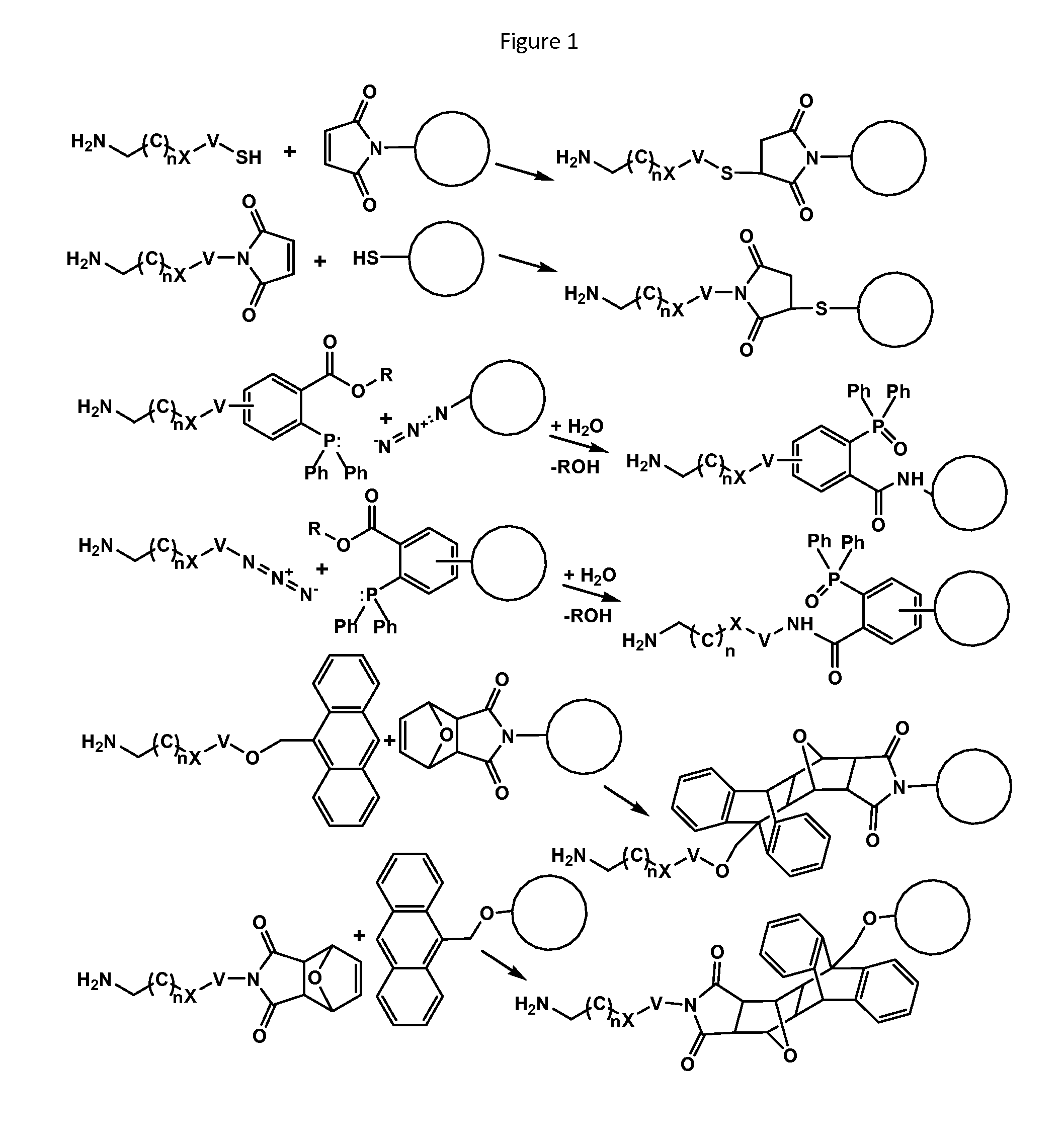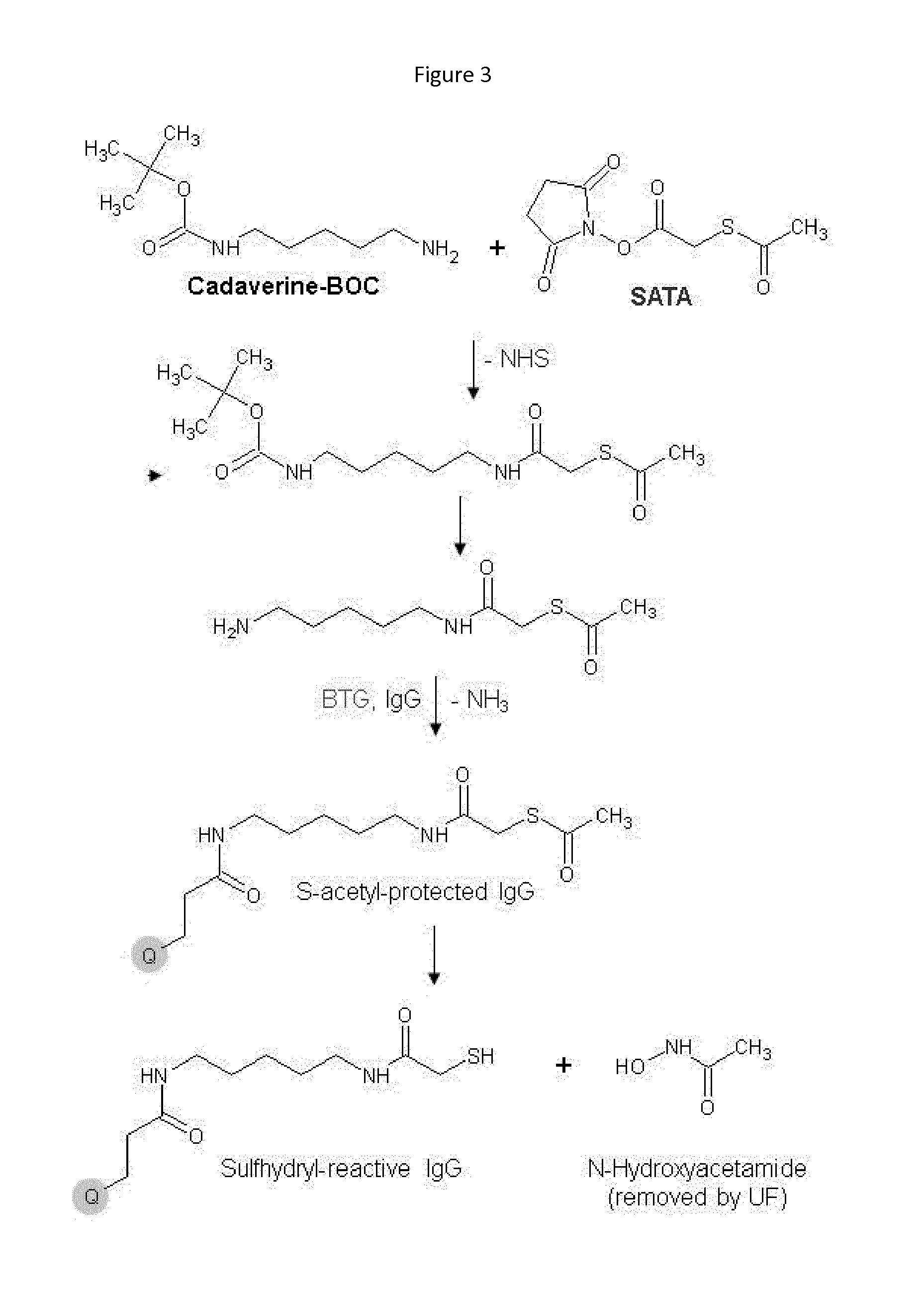Recognition tags for tgase-mediated conjugation
a recognition tag and polypeptide technology, applied in the field of polypeptide functionalization, can solve the problems of difficult screening of large numbers of antibodies for suitability for adc approaches, tedious screening of different components of bispecific antibodies to select the best constituent antibodies or fragments, and inability to detect tgase-mediated conjugation, etc., to achieve high stoichiometric and efficient conjugation, reduce production cost, and prevent auto-polymerization
- Summary
- Abstract
- Description
- Claims
- Application Information
AI Technical Summary
Benefits of technology
Problems solved by technology
Method used
Image
Examples
example 1
BTG-Mediated Coupling of Substrates to Single Chain Antibodies Via MYC Tags
Materials and Methods
[0410]Materials:
[0411]Recombinant proteins: scFv (myc-tagged); affibody (dimeric, myc-tagged); nanobody (myc-tagged; non-tagged). Ligands: biotin-cadaverine (Zedira); desferrioxamine (Sigma Aldrich). Enzyme: MTGase (Zedira). Myc-Tag sequence: EQKLISEEDL (SEQ ID NO: 1)
[0412]Enzymatic Modification of Recombinant Protein
[0413]1 mg / mL recombinant protein in PBS was incubated with 80 equivalents of ligand and 1 U / mL or >1 U / mL bacterial transglutaminase (BTGase, Zedira, Darmstadt, Germany) overnight at 37° C. Excess of ligand and the BTGase were removed by centrifugation-dialysis (Vivaspin MWCO 50 kDa, Vivascience, Winkel, Switzerland).
[0414]LC-MS Analysis
[0415]LC-MS analysis was performed on a Waters LCT Premier mass spectrometer. Samples were chromatographed on an Uptisphere 5BP1#15QS C18, 150×2 mm column heated to 40° C. using a linear gradient from 20 to 80% A in 20 min plus 5% solvent C (...
example 2
Synthesis of Bacterial Transglutaminase Substrates for Two-Step Reactions with and without Spacer Groups
Materials and Methods
[0427]All solvents used for reactions were purchased as anhydrous grade from Acros Organics (puriss., dried over molecular sieves, H2O254). Spots were visualized with UV light (λ=254 nm) or by staining with anisaldehyde solution or KMnO4 solution and subsequent heating. Chromatographic purification of products was performed using Fluka silica gel 60 for preparative column chromatography.
[0428]Nuclear magnetic resonance (NMR) spectra were recorded in CDCl3, CD3OD or D2O either on a Bruker Av-400 or a Bruker Av-500 spectrometer at room temperature. The measured chemical shifts are reported in δ (ppm) and the residual signal of the solvent was used as the internal standard (CDCl3 1H: δ=7.26 ppm, 13C: δ=77.0 ppm, CD3OD 1H: δ=3.31 ppm, 13C: δ=49.1 ppm, D2O 1H: δ=4.81 ppm). All 13C NMR spectra were measured with complete proton decoupling. Data of NMR spectra are re...
PUM
| Property | Measurement | Unit |
|---|---|---|
| Molar mass | aaaaa | aaaaa |
| Molar mass | aaaaa | aaaaa |
| Molar mass | aaaaa | aaaaa |
Abstract
Description
Claims
Application Information
 Login to View More
Login to View More - R&D
- Intellectual Property
- Life Sciences
- Materials
- Tech Scout
- Unparalleled Data Quality
- Higher Quality Content
- 60% Fewer Hallucinations
Browse by: Latest US Patents, China's latest patents, Technical Efficacy Thesaurus, Application Domain, Technology Topic, Popular Technical Reports.
© 2025 PatSnap. All rights reserved.Legal|Privacy policy|Modern Slavery Act Transparency Statement|Sitemap|About US| Contact US: help@patsnap.com



